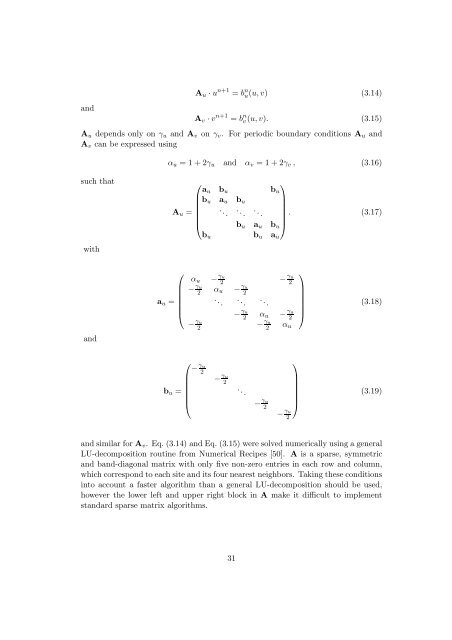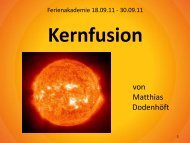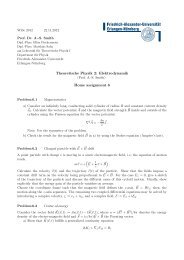Morphology of Experimental and Simulated Turing Patterns
Morphology of Experimental and Simulated Turing Patterns
Morphology of Experimental and Simulated Turing Patterns
You also want an ePaper? Increase the reach of your titles
YUMPU automatically turns print PDFs into web optimized ePapers that Google loves.
<strong>and</strong>A u · u n+1 = b n u (u,v) (3.14)A v · v n+1 = b n v(u,v). (3.15)A u depends only on γ u <strong>and</strong> A v on γ v . For periodic boundary conditions A u <strong>and</strong>A v can be expressed usingα u = 1 + 2γ u <strong>and</strong> α v = 1 + 2γ v , (3.16)such thatwith⎛⎞a u b u b ub u a u b uA u =. .. . .. . ... (3.17)⎜⎟⎝ b u a u b u⎠b u b u a u<strong>and</strong>⎛a u =⎜⎝⎞α u − γu 2− γu 2− γu 2α u − γu 2. .. . .. . ..⎟− γu 2α u − γu ⎠2− γu 2− γu 2α u(3.18)⎛b u =⎜⎝− γu 2− γu 2. ..− γu 2⎞⎟⎠(3.19)− γu 2<strong>and</strong> similar for A v . Eq. (3.14) <strong>and</strong> Eq. (3.15) were solved numerically using a generalLU-decomposition routine from Numerical Recipes [50]. A is a sparse, symmetric<strong>and</strong> b<strong>and</strong>-diagonal matrix with only five non-zero entries in each row <strong>and</strong> column,which correspond to each site <strong>and</strong> its four nearest neighbors. Taking these conditionsinto account a faster algorithm than a general LU-decomposition should be used,however the lower left <strong>and</strong> upper right block in A make it difficult to implementst<strong>and</strong>ard sparse matrix algorithms.31






